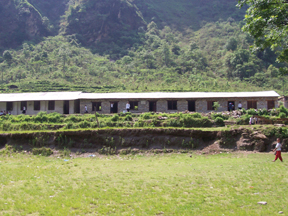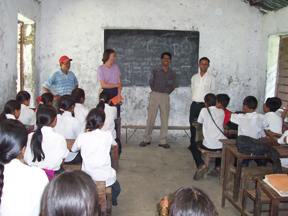
 The
Nepal Himalaya encompass some of the greatest contrasts our planet has to offer.
The top of Mount Everest, at 8,848 meters elevation, lies less than 150 kilometers
from the edge of the flat Ganges River plain, at less than 200 meters elevation.
Rainfall can vary even more than elevation: It tops 5 meters per year in places
along the range’s southern flanks, whereas only 40 kilometers to the north,
it barely reaches 50 centimeters per year.
The
Nepal Himalaya encompass some of the greatest contrasts our planet has to offer.
The top of Mount Everest, at 8,848 meters elevation, lies less than 150 kilometers
from the edge of the flat Ganges River plain, at less than 200 meters elevation.
Rainfall can vary even more than elevation: It tops 5 meters per year in places
along the range’s southern flanks, whereas only 40 kilometers to the north,
it barely reaches 50 centimeters per year. Last May, at the Shree Mahendra Dev Secondary School (shown at far left) in Taranache, Nepal, representatives of the Oneworld School Project dropped off letters from pen pals in California and met with the head science teacher to draw up a list of needed science equipment. At left, from left to right, field assistant Laksman Tamang, geologist Beth Pratt-Sitaula, guide Bhairab Sitaula and the class’ sixth-grade teacher talk to students. All images courtesy of Beth Pratt-Sitaula.
When I set out to study the rivers and glaciers of the central Nepal Himalaya as part of my Ph.D. geology thesis, I was (at least partially) prepared for the topographic and climatic contrasts before me. Still, the sheer size and extreme nature of the mountain system — 6,000-meter-deep valleys, raging rivers, landslides that extend over 40 kilometers and more — dominated my first encounter with the Himalaya.
After my senses adjusted to the new geologic scale, however, I began to notice the human side of the Himalaya more, and I sought to learn more about the villages through which my colleagues and I hiked. The true surprise — and possibly greatest learning experience — came from the range of educational and outreach opportunities that I encountered. The result has been an educational and cultural exchange between Nepali and Californian schools, which exemplifies how geologic research can be successfully combined with enriching student learning.
The children at the villages first pulled me into the project. They were particularly engaging — always fascinated with our scientific instruments and rock sampling — and led me to my first eye-opening visit to a rural Nepali school. I quickly saw that even the supplies we consider most basic, such as maps and alphabet charts, were lacking.
On my next visit to Nepal, I brought a load of donated maps to three of the schools in my field area. I sat down with the teachers at each school and asked them what supplies they wanted the most. They unanimously asked for science-related equipment, so they could move teaching science from books to a physical presence in the school. When I naively asked what additional supplies they would need, one teacher summed it up: “Anything would be helpful. We have no supplies for science education — none at all.”
When I returned home, I began soliciting donations of science materials from friends and colleagues. People responded enthusiastically, but the main items they donated were college textbooks — helpful for secondary school teachers and universities, but not the most useful for middle and high school students. I moved toward including more people in the endeavor and raising funds, so we could purchase science equipment to meet the specific needs of the Nepali public schools.
I also decided the time was ripe for educational opportunities on both sides of the Pacific. Drawing on contacts I had in the schools near my home in Goleta, Calif., I began a series of lectures and discussions on the geology and culture of central Nepal in fourth- to sixth-grade classes. The Californian students learned about monsoon weather systems and Himalayan geology and then found out about the lives of the people who call that area home. They also had the opportunity to question my husband, who was born and raised in the Nepal Himalaya.
The Californian students also wrote letters to Nepali pen pals and helped to raise money for bringing science supplies to their pen pals’ schools by making decorations and manning the ticket booth at a fundraising Nepali dinner and slide show. As letters came back from Nepal, the personal connection they gained from having friends in the Himalaya transformed that region from an intangibly remote place, known only as “where Mount Everest is,” to a location they could quickly locate on a globe and talk about, both geologically and culturally.
By spring of 2004, we had started a nonprofit organization called Oneworld School Project and raised enough funds to buy nearly all the supplies that the Nepali schools had asked for. In April, my field assistant and I delivered the equipment to the schools en route to our field work.
The students, who formerly had to learn about microscopes from a book, are now using them in earth science and biology classes. For field studies, they have hand lenses, as well as thermometers, barometers and precipitation gauges. Each school now has enough supplies (including lenses, prisms, chemicals and glassware) to conduct basic science demonstrations in physics and chemistry.
Besides the dinner fundraiser that the Californian students helped with, most of the funds came from donations by Himalayan geologists and trekkers. The project is still in its early stages. The headmasters, along with Oneworld School Project, have started to discuss the next step — helping each school to build a dedicated science laboratory and bringing local geology and earthquake safety into the curriculum.
This endeavor highlights how enriching it can be to bring education into an earth science research project and to combine the human element with the scientific. The geology and climate of the Himalaya is a very remote subject to many grade-school students, but it gains interest and relevance when they learn about it in the context of the people and culture of the area. Furthermore, outreach of this sort allows earth science researchers, like me, to give back to the communities in which they conduct their work.

